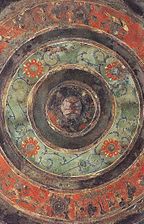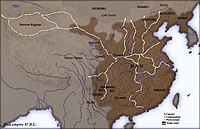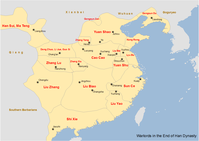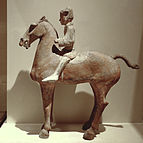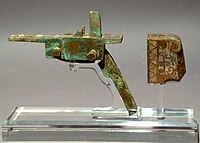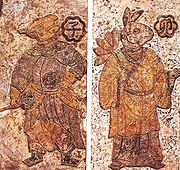Han dynasty
The "Scots" that wis uised in this airticle wis written bi a body that haesna a guid grip on the leid. Please mak this airticle mair better gin ye can. (Januar 2021) |
Han dynasty 漢朝 | |||||||||||
|---|---|---|---|---|---|---|---|---|---|---|---|
| 206 BC–220 AD | |||||||||||
![A cairt o the Wastren Han Dynasty in 2 AD: 1) the territory shadit in dark blue represents the principalities andcentrally-admeenistered commanderies o the Han Empire; 2) the licht blue aurie shaws the extent o the Tarim Basin pertectorate o the Wastren Regions.[1]](http://upload.wikimedia.org/wikipedia/commons/thumb/f/f9/Han_Dynasty_Plain_map.PNG/250px-Han_Dynasty_Plain_map.PNG) A cairt o the Wastren Han Dynasty in 2 AD: 1) the territory shadit in dark blue represents the principalities andcentrally-admeenistered commanderies o the Han Empire; 2) the licht blue aurie shaws the extent o the Tarim Basin pertectorate o the Wastren Regions.[1] | |||||||||||
| Status | Empire | ||||||||||
| Caipital | Chang'an (206 BC – 9 AD, 190–195 AD) Luoyang (25–190 AD, 196 AD) Xuchang (196–220 AD) | ||||||||||
| Common leids | Auld Cheenese | ||||||||||
| Releegion | Taoism, Confucianism, Cheenese folk releegion | ||||||||||
| Govrenment | Monarchy | ||||||||||
| Emperor | |||||||||||
• 202–195 BC | Emperor Gaozu | ||||||||||
• 25–57 AD | Emperor Guangwu | ||||||||||
| Chancellor | |||||||||||
• 206–193 BC | Xiao He | ||||||||||
• 193–190 BC | Cao Can | ||||||||||
• 189–192 AD | Dong Zhuo | ||||||||||
• 208–220 AD | Cao Cao | ||||||||||
• 220 AD | Cao Pi | ||||||||||
| History | |||||||||||
• Establishment | 206 BC | ||||||||||
• Battle o Gaixia; Han rule o Cheenae begins | 202 BC | ||||||||||
| 9–23 | |||||||||||
• Abdication tae Cao Wei | 220 AD | ||||||||||
| Aurie | |||||||||||
| 50 BC est.[2] | 6,000,000 km2 (2,300,000 sq mi) | ||||||||||
| Population | |||||||||||
• 2 AD[3] | 57,671,400 | ||||||||||
| Currency | Ban liang coins an wu zhu coins | ||||||||||
| |||||||||||
| The day pairt o | |||||||||||
The Han dynasty (simplifeed Cheenese: 汉朝; traditeeonal Cheenese: 漢朝; pinyin: Hàn Cháo; Wade–Giles: Han Ch'ao; IPA: [xân tʂʰɑ̌ʊ̯]) wis the seicont imperial dynasty o Cheenae, precedit bi the Qin dynasty (221–207 BC) an succeedit bi the Three Kinricks period (220–280 AD). Spannin ower fower centuries, the Han period is conseedert a gowden age in Cheenese history.[4] Tae this day, Cheenae's majority ethnic group refers tae themsels as the "Han Cheenese" an the Cheenese script is referred tae as "Han chairacters".[5] It wis foondit bi the rebel leader Liu Bang, kent posthumously as Emperor Gaozu o Han, an briefly interruptit bi the Xin dynasty (9–23 AD) o the umwhile regent Wang Mang. This interregnum separates the Han dynasty intae twa periods: the Wastren Han or Umwhile Han (206 BC – 9 AD) an the Eastren Han or Later Han (25–220 AD).
The emperor wis at the pinnacle o Han society. He presidit ower the Han govrenment but shared pouer wi baith the nobility an appyntit meenisters that cam lairgely frae the scholarly gentry cless. The Han Empire wis dividit intae auries directly controlled bi the central govrenment uisin an innovation inheritit frae the Qin kent as commanderies, an a nummer o semi-autonomous kinricks. Thir kinricks gradually lost aw vestiges o thair unthirldom, pairteecularly follaein the Rebellion o the Seiven States. Frae the ring o Emperor Wu (r. 141–87 BC) onwart, the Cheenese coort offeecially sponsored Confucianism in eddication an coort politics, synthesised wi the cosmology o later scholarts sic as Dong Zhongshu. This policy endured till the faw o the Qing dynasty in 1911 AD.
The Han dynasty saw an age o economic prosperity an witnessed a signrrficant growthe o the money economy first established in the Zhou dynasty (c. 1050–256 BC). The coinage issued bi the central govrenment mint in 119 BC remeened the staundart coinage o Cheenae till the Tang dynasty (618–907 AD). The period saw a nummer o leemitit institutional innovations. Tae finance its militar campaigns an the dounset o newly conquered frontier territories, the Han govrenment naitionalised the preevat saut an airn industries in 117 BC, but thir govrenment monopolies war repealed in the Eastren Han dynasty. Science an technology in the Han period saw signeeficant advances, includin the process o papermakin, the nautical steerin ship rither, the uise o negative nummers in mathematics, the raised-relief map, the hydraulic-pouered armillary sphere for astronomy, an a seismometer employin an invertit pendulum that coud be uised tae discern the cardinal direction o distant yirdquauks.
The Xiongnu, a nomadic steppe confederation,[6] defeatit the Han in 200 BC an forced the Han tae submit as a de facto inferior an vassal pairtner, but conteena'd thair militar raids on the Han mairches. Emperor Wu launched several militar campaigns against them. The ultimate Han veectory in thir wars eventually forced the Xiongnu tae accept vassal status as Han tributaries. Thir campaigns expandit Han sovereignty intae the Tarim Basin o Central Asie, dividit the Xiongnu intae twa separate confederations, an helped establish the vast tred netwark kent as the Silk Road, that reached as faur as the Mediterranean warld. The territories north o Han's mairches war quickly owerrun bi the nomadic Xianbei confederation. Emperor Wu launched successfu militar expedeetions in the sooth forby, annexin Nanyue in 111 BC an Dian in 109 BC, an in the Korean Peninsula whaur the Xuantu an Lelang Commanderies war established in 108 BC. Efter 92 AD, the pailace eunuchs increasinly involved themsels in coort politics, engagin in veeolent pouer struggles atween the various consort clans o the empresses an empresses dowager, causin the Han's ultimate dounfaw. Imperial authority wis seriously challenged bi lairge Daoist releegious societies that instigatit the Yellae Turban Rebellion an the Five Pecks o Rice Rebellion forby. Follaein the daith o Emperor Ling (r. 168–189 AD), the pailace eunuchs suffered wholesale massacre bi militar officers, allouin members o the aristocracy an militar govrenors tae acome warlairds an divide the empire. Whan Cao Pi, King o Wei, usurped the throne frae Emperor Xian, the Han dynasty ceased tae exeest.
History
[eedit | eedit soorce]Wastren Han
[eedit | eedit soorce]Richt eemage: Reverse side o a Wastren-Han bronze mirror with painted designs of a flower motif
Cheenae's first imperial dynasty wis the Qin dynasty (221–207 BC). The Qin unifee'd the Cheenese Warrin States bi conquest, but thair empire becam unstable efter the daith o the first emperor Qin Shi Huang. Within fower years, the dynasty's authority haed collapsed in the face o rebellion.[7] Twa umwhile rebel leaders, Xiang Yu (d. 202 BC) o Chu an Liu Bang (d. 195 BC) o Han, engaged in a war tae decide that wad acome hegemon o Cheenae, that haed fissured intae 18 kinricks, each claimin allegiance tae aither Xiang Yu or Liu Bang.[8] Awtho Xiang Yu pruived tae be a capable commander, Liu Bang defeatit him at Battle o Gaixia (202 BC), in modren-day Anhui. Liu Bang assumed the teetle "emperor" (huangdi) at the urgin o his follaers an is kent posthumously as Emperor Gaozu (r. 202–195 BC).[9] Chang'an (kent the day as Xi'an) wis chosen as the new caipital of the reunified empire unner Han.[10]
At the beginnin o the Wastren Han (traditeeonal Cheenese: 西漢; simplifeed Cheenese: 西汉; pinyin: Xīhàn), kent as the Umwhile Han (traditeeonal Cheenese: 前漢; simplifeed Cheenese: 前汉; pinyin: Qiánhàn) dynasty forby, thirteen centrally controlled commanderies—includin the caipital region—existit in the wastren third o the empire, while the eastren twa-thirds war dividit intae ten semi-autonomous kinricks.[11] Tae placate his prominent commanders frae the war wi Chu, Emperor Gaozu enfeoffed some o them as kings. Bi 157 BC, the Han coort haed replaced aw o thir kings wi ryal Liu faimily members, syne the lealty o non-relatives tae the throne wis quaistened.[11] Efter several insurrections bi Han kings—the lairgest bein the Rebellion o the Seiven States in 154 BC—the imperial coort enactit a series o reforms beginnin in 145 BC leemitin the size an pouer o thir kinricks an dividin thair umwhile territories intae new centrally controlled commanderies.[12] Kings war na langer able tae appynt thair ain staff; this duty wis assumed bi the imperial coort.[13] Kings becam nominal heads of thair fiefs an collectit a portion of tax revenues as thair personal incomes.[13] The kinricks war niver entirely abolished an existit ootthrou the remeender o Wastren an Eastren Han.[14]

Tae the north o Cheenae proper, the nomadic Xiongnu chieftain Modu Chanyu (r. 209–174 BC) conquered various tribes inhabitin the eastren portion o the Eurasian Steppe. Bi the end o his ring, he controlled Manchurie, Mongolie, an the Tarim Basin, subjugatin ower twinty states east o Samarkand.[16] Emperor Gaozu wis tribbled aboot the abundant Han-manufactured airn wappens treddit tae the Xiongnu alang the northren mairches, an he established a tred embargo against the group.[17] In retaliation, the Xiongnu invadit whit is nou Shanxi province, whaur thay defeat the Han forces at Baideng in 200 BC.[18] Efter negotiations, the heqin greement in 198 BC nominally held the leaders o the Xiongnu an the Han as equal partners in a royal marriage alliance, but the Han war forced tae send muckle amunts o treebute eetems sic as silken claes, fuid, an wine tae the Xiongnu.[19]

Despite the treebute an a negotiation atween Laoshang Chanyu (r. 174–160 BC) an Emperor Wen (r. 180–157 BC) tae reappen mairch mercats, mony o the Chanyu's Xiongnu subordinates chuise nae tae obey the treaty an periodically raidit Han territories sooth o the Great Waw for addeetional guids.[21] In a coort conference assembled bi Emperor Wu (r. 141–87 BC) in 135 BC, the majority consensus o the meenisters wis tae retain the heqin greement. Emperor Wu acceptit this, despite conteenuin Xiongnu raids.[22] Houiver, a coort conference the follaein year convinced the majority that a leemitit engagement at Mayi involvin the assassination o the Chanyu wad thraw the Xiongnu realm intae chaos an benefit the Han.[23] Whan this plot failed in 133 BC,[24] Emperor Wu launched a series o massive militar invasions intae Xiongnu territory. The assaut culminatit in 119 BC at the Battle o Mobei, whaur the Han commanders Huo Qubing (d. 117 BC) an Wei Qing (d. 106 BC) forced the Xiongnu coort tae flee north o the Gobi Desert.[25]
Efter Wu's reign, Han forces conteena'd tae prevail against the Xiongnu. The Xiongnu leader Huhanye Chanyu (呼韓邪) (r. 58–31 BC) feenally submittit tae Han as a tributar vassal in 51 BC. His rival claimant tae the throne, Zhizhi Chanyu (r. 56–36 BC), wis killt bi Chen Tang an Gan Yanshou (甘延壽/甘延寿) at the Battle o Zhizhi, in modren Taraz, Kazakhstan.[26]
In 121 BC, Han forces expelled the Xiongnu frae a vast territory spannin the Hexi Corridor tae Lop Nur. Thay repelled a jynt Xiongnu-Qiang invasion o this northwastren territory in 111 BC. In that year, the Han coort established fower new frontier commanderies in this region: Jiuquan, Zhangyi, Dunhuang, an Wuwei.[27] The majority o fowk on the frontier war sodgers.[28] On occasion, the coort forcibly muived paisant farmers tae new frontier settlements, alang wi govrenment-awned sclaves an convicts that performed haurd laubour.[29] The coort encouraged commoners, sic as fermers, merchands, laundawners, an hired laubourers, tae voluntarily migrate tae the mairches forby.[30]
Even afore Han's expansion intae Central Asie, diplomat Zhang Qian's traivels frae 139 tae 125 BC haed established Cheenese contacts wi mony surroondin ceevilisations. Zhang encoontered Dayuan (Fergana), Kangju (Sogdiana), an Daxia (Bactrie, umwhile the Greco-Bactrian Kinrick); he gaithert information on Shendu (Indus River valley o North Indie) an Anxi (the Parthian Empire) forby. Aw o thir kintras eventually received Han embassies.[31] Thir connections merked the beginnin o the Silk Road trede netwark that extendit tae the Roman Empire, bringin Han eetems lik silk tae Roum an Roman guids sic as glesswares tae Cheenae.[32]
Frae rochly 115 tae 60 BC, Han forces focht the Xiongnu ower control o the oasis ceity-states in the Tarim Basin. Han wis eventually veectorious an established the Pertectorate o the Wastren Regions in 60 BC, that dealt wi the region's defence an furrin affairs.[33] The Han expandit soothwart forby. The naval conquest o Nanyue in 111 BC expandit the Han realm intae whit are nou modren Guangdong, Guangxi, an northren Vietnam. Yunnan wis brocht intae the Han realm wi the conquest o the Dian Kinrick in 109 BC, follaed bi pairts o the Korean Peninsula wi the Han conquest o Gojoseon an colonial establishments o Xuantu Commandery an Lelang Commandery in 108 BC.[34] In Cheenae's first kent nationwide census taken in 2 AD, the population wis registered as haein 57,671,400 individuals in 12,366,470 households.[35]
Tae pey for his militar campaigns an colonial expansion, Emperor Wu naitionalised several preevat industries. He creatit central govrenment monopolies admeenistered lairgely bi umwhile merchants. Thir monopolies includit saut, airn, an liquor production, as weel as bronze-cunyie currency. The liquor monopoly lastit anly frae 98 tae 81 BC, an the saut an airn monopolies war eventually abolished in early Eastren Han. The issuin o coinage remeened a central govrenment monopoly ootthrou the rest o the Han dynasty.[36] The govrenment monopolies war eventually repealed whan a poleetical faction kent as the Reformists gained greater influence in the coort. The Reformists opponed the Modrenist faction that haed dominatit coort politics in Emperor Wu's ring an in the subsequent regency o Huo Guang (d. 68 BC). The Modrenists airgie'd for an aggressive an expansionary furrin policy supportit bi revenues frae hivy govrenment intervention in the preevat economy. The Reformists, houiver, owerturned thir policies, favourin a cautious, non-expansionary approach tae furrin policy, frugal budget reform, an lawer tax-rates imponed on preevat entrepreneurs.[37]
Wang Mang's reign an ceevil war
[eedit | eedit soorce]Wang Zhengjun (71 BC–13 AD) wis first empress, then empress dowager, an feenally grand empress dowager in the rings o the Emperors Yuan (r. 49–33 BC), Cheng (r. 33–7 BC), an Ai (r. 7–1 BC), respectively. In this time, a succession o her male relatives held the teetle o regent.[38] Follaein the daith o Ai, Wang Zhengjun's neffae Wang Mang (45 BC–23 AD) wis appyntit regent as Marshall o State on 16 August unner Emperor Ping (r. 1 BC–6 AD).[39] Whan Ping dee'd on 3 Februar 6 AD, Ruzi Ying (d. 25 AD) wis chuisen as the heir an Wang Mang wis appyntit tae serve as actin emperor for the bairn.[39] Wang promised tae relinquish his control tae Liu Ying ance he came of age.[39] Despite this promise, an against protest an revolts frae the nobility, Wang Mang claimed on 10 Januar that the divine Mandate o Heiven cried for the end o the Han dynasty an the beginnin o his ain: the Xin dynasty (9–23 AD).[40]
Wang Mang ineetiatit a series o major reforms that war ultimately unsuccessfu. Thir reforms includit ootlawin sclavery, naitionalisin laund tae equally distribute atween hoosehauds, an introducin new sillers, a chynge that debased the vailyie o coinage.[41] Awtho thir reforms provoked conseederable opposeetion, Wang's regime met its ultimate dounfaw wi the massive fluids o c. 3 AD an 11 AD. Gradual silt bigup in the Yellae River haed raised its watter level an owerwhelmed the fluid control warks. The Yellae River split intae twa new brainches: ane emptiein tae the north an the ither tae the sooth o the Shandong Peninsula, tho Han ingineers managed tae dam the soothren branch bi 70 AD.[42]
The fluid dislodged thoosands o paisant fermers, mony o whom jynt rovin bandit an rebel groups sic as the Reid Eebrous tae survive.[42] Wang Mang's airmies war incapable o quellin thir enlairged rebel groups. Eventually, an insurgent mob forced thair wey intae the Weiyang Pailace an killt Wang Mang.[43]
The Gengshi Emperor (r. 23–25 AD), a descendant o Emperor Jing (r. 157–141 BC), attemptit tae restore the Han dynasty an occupied Chang'an as his caipital. Houiver, he wis owerwhelmed bi the Reid Eebrou rebels that deponed, assassinatit, an replaced him wi the puppet monarch Liu Penzi.[44] Gengshi's distant cousin Liu Xiu, kent posthumously as Emperor Guangwu (r. 25–57 AD), efter distinguishin himsel at the Battle o Kunyang in 23 AD, wis urged tae succeed Gengshi as emperor.[45]
Unner Guangwu's rule the Han Empire wis restored. Guangwu made Luoyang his caipital in 25 AD, an bi 27 AD his officers Deng Yu an Feng Yi haed forced the Reid Eebrous tae surrender an executit thair leaders for traison.[46] Frae 26 till 36 AD, Emperor Guangwu haed tae wage war against ither regional warlairds that claimed the teetle o emperor; whan thir warlords war defeatit, Cheenae reunifee'd unner the Han.[47]
The period atween the foondation o the Han dynasty an Wang Mang's reign is kent as the Wastren Han (traditeeonal Cheenese: 西漢; simplifeed Cheenese: 西汉; pinyin: Xīhàn) or Former Han (traditeeonal Cheenese: 前漢; simplifeed Cheenese: 前汉; pinyin: Qiánhàn) (206 BC–9 AD). During this period the caipital wis at Chang'an (modren Xi'an). Frae the ring o Guangwu the caipital wis moved eastward tae Luoyang. The era frae his reign till the faw o Han is kent as the Eastern Han or Later Han (25–220 AD).[48]
Eastren Han
[eedit | eedit soorce]

The Eastren Han (traditeeonal Cheenese: 東漢; simplifeed Cheenese: 东汉; pinyin: Dōnghàn), kent as the Later Han (traditeeonal Cheenese: 後漢; simplifeed Cheenese: 后汉; pinyin: Hòuhàn) forby, formally begoud on 5 August 25, whan Liu Xiu becam Emperor Guangwu o Han.[49] In the widespreid rebellion against Wang Mang, the state o Goguryeo wis free tae raid Han's Korean commanderies; Han did nae reaffirm its control ower the region till AD 30.[50] The Trưng Sisters o Vietnam rebelled against Han in AD 40. Thair rebellion wis crushed bi Han general Ma Yuan (d. AD 49) in a campaign frae AD 42–43.[51] Wang Mang renewed hostilities against the Xiongnu, that war estranged frae Han till thair leader Bi (比), a rival claimant tae the throne against his cuisin Punu (蒲奴), submitted tae Han as a tributar vassal in AD 50. This creatit twa rival Xiongnu states: the Soothren Xiongnu led bi Bi, an ally o Han, an the Northren Xiongnu led bi Punu, an enemy o Han.[52]
In the turbulent ring o Wang Mang, Cheenae lost control ower the Tarim Basin, that wis conquered bi the Northren Xiongnu in AD 63 an uised as a base tae invade the Hexi Corridor in Gansu.[53] Dou Gu (d. 88 AD) defeatit the Northren Xiongnu at the Battle o Yiwulu in AD 73, evictin them frae Turpan an chasin them as faur as Loch Barkol afore establishin a garrison at Hami.[54] Efter the new Pertector General o the Wastren Regions Chen Mu (d. AD 75) wis killt bi allies o the Xiongnu in Karasahr an Kucha, the garrison at Hami wis widrawn.[55] At the Battle o Ikh Bayan in AD 89, Dou Xian (d. AD 92) defeatit the Northren Xiongnu chanyu that then retreatit intae the Altai Muntains.[56] Efter the Northren Xiongnu fled intae the Ili River valley in AD 91, the nomadic Xianbei occupied the aurie frae the mairches o the Buyeo Kinrick in Manchurie tae the Ili River o the Wusun fowk.[57] The Xianbei reached thair apogee unner Tanshihuai (檀石槐) (d. AD 180), that consistently defeatit Cheenese airmies. Houiver, Tanshihuai's confederation disintegratit efter his daith.[58]
Ban Chao (d. AD 102) enleetit the aid o the Kushan Empire, occupyin the aurie o modren Indie, Pakistan, Afghanistan, an Tajikistan, tae subdue Kashgar an its ally Sogdiana.[59] Whan a request bi Kushan ruler Vima Kadphises (r. c. 90–c. 100 AD) for a mairiage alliance wi the Han wis rejectit in AD 90, he sent his forces tae Wakhan (Afghanistan) tae attack Ban Chao. The conflict endit wi the Kushans widrawin acause o lack o supplees.[59] In AD 91, the office o Pertector General o the Wastren Regions wis reinstated whan it wis bestawed on Ban Chao.[60]

Furrin traivellers tae Eastren-Han Cheenae include Buddhist monks that translatit warks intae Cheenese, sic as An Shigao frae Parthie, an Lokaksema frae Kushan-era Gandhara, Indie.[62] In addeetion tae tributar relations wi the Kushans, the Han Empire received gifts frae the Parthian Empire, frae a king in modren Burma, frae a ruler in Japan, an ineetiatit an unsuccessfu mission tae Daqin (Roum) in AD 97 wi Gan Ying as emissar.[63] A Roman embassy o Emperor Marcus Aurelius (r. 161–180 AD) is recordit in the Weilüe an Hou Hanshu tae hae reached the coort o Emperor Huan o Han (r. AD 146–168) in AD 166,[64][65] yet Rafe de Crespigny asserts that this wis maist likely a group o Roman merchands.[66] In addeetion tae Roman glesswares an cunyies foond in Cheenae,[67] Roman medallions frae the ring o Antoninus Pius an his adoptit son Marcus Aurelius hae been foond at Óc Eo in Vietnam.[68] This wis near the commandery o Rinan (Jiaozhi forby) whaur Cheenese soorces claim the Romans first laundit, as weel as embassies frae Tianzhu (in northren Indie) in the years 159 an 161.[69] Óc Eo is thocht tae be the port ceity "Cattigara" descrived bi Ptolemy in his Geografie (c. 150 AD) as lyin east o the Gowden Chersonese (Malay Peninsula) alang the Magnus Sinus (i.e. Gulf o Thailand an Sooth Cheenae Sea), whaur a Greek sailor haed veesitit.[70]

Emperor Zhang's (r. 75–88 AD) ring came tae be viewed bi later Eastren Han scholars as the heich pynt o the dynastic hoose.[71] Subsequent rings war increasinly merked bi eunuch intervention in coort politics an thair involvement in the veeolent pouer struggles o the imperial consort clans.[72] Wi the aid o the eunuch Zheng Zhong (d. 107 AD), Emperor He (r. 88–105 AD) haed Empress Dowager Dou (d. 97 AD) put unner hoose arrest an her clan stripped o pouer. This wis in revenge for Dou's purgin o the clan o his naitural mither—Consort Liang—an then concealin her identity frae him.[73] Efter Emperor He's daith, his wife Empress Deng Sui (d. 121 AD) managed state affairs as the regent empress dowager in a turbulent financial creesis an widespreid Qiang rebellion that lastit frae 107 tae 118 AD.[74]
Whan Empress Dowager Deng dee'd, Emperor An (r. 106–125 AD) wis convinced bi the accusations o the eunuchs Li Run (李閏) an Jiang Jing (江京) that Deng an her faimily haed planned tae depone him. An dismissed Deng's clan members frae office, exiled them an forced mony tae commit suicide.[75] Efter An's daith, his wife, Empress Dowager Yan (d. 126 AD) placed the bairn Marquess o Beixiang on the throne in an attempt tae retain pouer within her faimily. Houiver, pailace eunuch Sun Cheng (d. 132 AD) mastermyndit a successfu owerthraw o her regime tae enthrone Emperor Shun o Han (r. 125–144 AD). Yan wis placed unner hoose arrest, her relatives war aither killt or exiled, an her eunuch allies war slauchtert.[76] The regent Liang Ji (d. 159 AD), brither o Empress Liang Na (d. 150 AD), haed the brither-in-law o Consort Deng Mengnü (later empress) (d. 165 AD) killed efter Deng Mengnü resistit Liang Ji's attempts tae control her. Efterwart, Emperor Huan employed eunuchs tae depone Liang Ji, who wis then forced tae commit suicide.[77]

Students frae the Imperial Varsity organised a widespread student protest against the eunuchs o Emperor Huan's coort.[79] Huan faur alienatit the bureaucracy whan he ineetiatit grandiose construction projects an hostit thoosands o concubines in his harem at a time o economic creesis.[80] Pailace eunuchs impreesoned the offeecial Li Ying (李膺) an his associates frae the Imperial Varsity on a dubious chairge o traison. In 167 AD, the Grand Commandant Dou Wu (d. 168 AD) convinced his son-in-law, Emperor Huan, tae release them.[81] Houiver the emperor permanently baured Li Ying an his associates frae servin in office, merkin the beginnin o the Pairtisan Prohibeetions.[81]
Follaein Huan's daith, Dou Wu an the Grand Tutor Chen Fan (陳蕃) (d. 168 AD) attemptit a coup d'état against the eunuchs Hou Lan (d. 172 AD), Cao Jie (d. 181 AD), an Wang Fu (王甫). When the plot wis unkivert, the eunuchs arrestit Empress Dowager Dou (d. 172 AD) an Chen Fan. General Zhang Huan (張奐) favourt the eunuchs. He an his truips confrontit Dou Wu an his reteeners at the pailace gate whaur ilk side shootit accusations o traison against the ither. Whan the reteeners gradually desertit Dou Wu, he wis forced tae commit suicide.[82]
Unner Emperor Ling (r. 168–189 AD) the eunuchs haed the pairtisan prohibeetions renewed an expandit, while auctionin aff tap govrenment offices forby.[83] Mony affairs o state war entrusted tae the eunuchs Zhao Zhong (d. 189 AD) an Zhang Rang (d. 189 AD) while Emperor Ling spent muckle o his time roleplayin wi concubines an pairteecipatin in militar parades.[84]
End o the Han dynasty
[eedit | eedit soorce]The Pairtisan Prohibeetions war repealed in the Yellae Turban Rebellion an Five Pecks o Rice Rebellion in 184 AD, lairgely acause the court did nae want tae continue tae alienate a signeeficant portion o the gentry cless that micht otherwise jyne the rebellions.[85] The Yellae Turbans an Five-Pecks-o-Rice adherents belanged tae twa different hierarchical Daoist releegious societies led bi faith healers Zhang Jue (d. 184 AD) an Zhang Lu (d. 216 AD), respectively. Zhang Lu's rebellion, in modren northern Sichuan an soothren Shaanxi, wis nae quelled till 215 AD.[86] Zhang Jue's massive rebellion across aicht provinces wis annihilatit bi Han forces within a year, houiver the follaein decades saw muckle smawer recurrent uprisins.[87] Awtho the Yellae Turbans war defeatit, mony generals appyntit in the creesis niver disbaundit thair assemmled militia forces an uised thir truips tae amass pouer ootside o the collapsin imperial authority.[88]
General-in-Chief He Jin (d. 189 AD), hauf-brither tae Empress He (d. 189 AD), plottit wi Yuan Shao (d. 202 AD) tae owerthraw the eunuchs bi haein several generals mairch tae the ootskirts o the caipital. Thare, in a written peteetion tae Empress He, thay demandit the eunuchs' execution.[89] Efter a period o hesitation, Empress He consentit. Whan the eunuchs diskivert this, houiver, thay haed her brither He Miao (何苗) rescind the order.[90] The eunuchs assassinatit He Jin on 22 September 189 AD. Yuan Shao then besieged Luoyang's Northren Pailace while his brither Yuan Shu (d. 199 AD) besieged the Soothren Pailace. On 25 September baith pailaces war breached an approximately twa thoosand eunuchs war killt.[91] Zhang Rang haed previously fled wi Emperor Shao (r. 189 AD) an his brither Liu Xie—the futur Emperor Xian o Han (r. 189–220 AD). While bein pursued bi the Yuan brithers, Zhang committit suicide bi jimpin intae the Yellae River.[92]
Richt: Detail o a mural shawin twa weemen weirin Hanfu silk robes, frae the Dahuting Tomb (打虎亭汉墓; Dáhǔtíng hànmù) o the late Eastren Han Dynasty (25–220 AD), locatit in Zhengzhou, Henan
General Dong Zhuo (d. 192 AD) foond the young emperor an his brither wanderin in the kintraside. He escortit them saufly back tae the caipital an wis made Meenister o Warks, takkin control o Luoyang an forcin Yuan Shao tae flee.[94] Efter Dong Zhuo demotit Emperor Shao an promotit his brither Liu Xie as Emperor Xian, Yuan Shao led a coaleetion o umwhile offeecials an officers against Dong, that borned Luoyang tae the grund an resettled the coort at Chang'an in Mey 191 AD. Dong Zhuo later pushioned Emperor Shao.[95]
Dong wis killt bi his adoptit son Lü Bu (d. 198 AD) in a plot hatched bi Wang Yun (d. 192 AD).[96] Emperor Xian fled frae Chang'an in 195 AD tae the ruins o Luoyang. Xian wis persuaded bi Cao Cao (155–220 AD), then Govrenor o Yan Province in modren wastren Shandong an eastren Henan, tae muive the caipital tae Xuchang in 196 AD.[97]
Yuan Shao challenged Cao Cao for control ower the emperor. Yuan's pouer wis greatly diminished efter Cao defeatit him at the Battle o Guandu in 200 AD. Efter Yuan dee'd, Cao killt Yuan Shao's son Yuan Tan (173–205 AD), that haed focht wi his brithers ower the faimily inheritance.[98] His brithers Yuan Shang an Yuan Xi war killt in 207 AD bi Gongsun Kang (d. 221 AD), that sent thair heids tae Cao Cao.[98]
Efter Cao's defeat at the naval Battle o Reid Cliffs in 208 AD, Cheenae wis dividit intae three spheres o influence, wi Cao Cao dominatin the north, Sun Quan (182–252 AD) dominatin the sooth, an Liu Bei (161–223 AD) dominatin the wast.[99] Cao Cao died in Mairch 220 AD. Bi December his son Cao Pi (187–226 AD) haed Emperor Xian relinquish the throne tae him an is kent posthumously as Emperor Wen o Wei. This formally endit the Han dynasty an ineetiatit an age o conflict atween three states: Cao Wei, Eastren Wu, an Shu Han.[100]
References
[eedit | eedit soorce]- ↑ "MAPPING HISTORY WORLD HISTORY", Dr. Ian Barnes.ISBN 978-1-84573-323-0
- ↑ Turchin, Peter; Adams, Jonathan M.; Hall, Thomas D (December 2006). "East-West Orientation of Historical Empires" (PDF). Journal of world-systems research. 12 (2): 219–229. ISSN 1076-156X. Archived frae the original (PDF) on 22 Februar 2007. Retrieved 12 August 2010.
- ↑ Nishijima (1986), 595–596.
- ↑ Zhou (2003), p. 34.
- ↑ Schaefer (2008), p. 279.
- ↑ Bailey (1985), pp. 25–26.
- ↑ Ebrey (1999), pp. 60–61.
- ↑ Loewe (1986), pp. 116–122.
- ↑ Davis (2001), pp. 44–46.
- ↑ Loewe (1986), p. 122.
- ↑ a b Loewe (1986), pp. 122–125.
- ↑ Loewe (1986), pp. 139–144.
- ↑ a b Bielenstein (1980), p. 106; Ch'ü (1972), p. 76.
- ↑ Bielenstein (1980), p. 105.
- ↑ Ebrey (1999), p. 66; Wang (1982), p. 100.
- ↑ Di Cosmo (2002), pp. 175–189, 196–198; Torday (1997), pp. 80–81; Yü (1986), pp. 387–388.
- ↑ Torday (1997), pp. 75–77.
- ↑ Torday (1997), pp. 75–77; Di Cosmo (2002), pp. 190–192.
- ↑ Yü (1967), pp. 9–10; Morton & Lewis (2005), p. 52; Di Cosmo (2002), pp. 192–195.
- ↑ Hansen (2000), pp. 117–119.
- ↑ Yü (1986), pp. 388–389; Torday (1997), pp. 77, 82–83; Di Cosmo (2002), pp. 195–196.
- ↑ Torday (1997), pp. 83–84; Yü (1986), pp. 389–390.
- ↑ Yü (1986), pp. 389–391; Di Cosmo (2002), pp. 211–214.
- ↑ Torday (1997), pp. 91–92.
- ↑ Yü (1986), p. 390; Di Cosmo (2002), pp. 237–240.
- ↑ Loewe (1986), pp. 196–197, 211–213; Yü (1986), pp. 395–398.
- ↑ Chang (2007), pp. 5–8; Di Cosmo (2002), pp. 241–242; Yü (1986), p. 391.
- ↑ Chang (2007), pp. 34–35.
- ↑ Chang (2007), pp. 6, 15–16, 44–45.
- ↑ Chang (2007), pp. 15–16, 33–35, 42–43.
- ↑ Di Cosmo (2002), pp. 247–249; Morton & Lewis (2005), pp. 54–55; Yü (1986), p. 407; Ebrey (1999), p. 69; Torday (1997), pp. 104–117.
- ↑ An (2002), p. 83; Ebrey (1999), p. 70.
- ↑ Di Cosmo (2002), pp. 250–251; Yü (1986), pp. 390–391, 409–411; Chang (2007), p. 174; Loewe (1986), p. 198.
- ↑ Ebrey (1999), p. 83; Yü (1986), pp. 448–453.
- ↑ Nishijima (1986), pp. 595–596.
- ↑ Wagner (2001), pp. 1–17; Loewe (1986), pp. 160–161; Nishijima (1986), pp. 581–588; Ebrey (1999), p. 75; Morton & Lewis (2005), p. 57; see Hinsch (2002), pp. 21–22 as weel.
- ↑ Loewe (1986), pp. 162, 185–206; Paludan (1998), p. 41; Wagner (2001), pp. 16–19.
- ↑ Bielenstein (1986), pp. 225–226; Huang (1988), pp. 46–48.
- ↑ a b c Bielenstein (1986), pp. 227–230.
- ↑ Hinsch (2002), pp. 23–24; Bielenstein (1986), pp. 230–231; Ebrey (1999), p. 66.
- ↑ Hansen (2000), p. 134; Bielenstein (1986), pp. 232–234; Morton & Lewis (2005), p. 58; Lewis (2007), p. 23.
- ↑ a b Hansen (2000), p. 135; de Crespigny (2007), p. 196; Bielenstein (1986), pp. 241–244.
- ↑ de Crespigny (2007), p. 568; Bielenstein (1986), p. 248.
- ↑ de Crespigny (2007), pp. 197, 560; Bielenstein (1986), pp. 249–250.
- ↑ de Crespigny (2007), pp. 558–560; Bielenstein (1986), pp. 251–254.
- ↑ Bielenstein (1986), pp. 251–254; de Crespigny (2007), pp. 196–198, 560.
- ↑ de Crespigny (2007), pp. 54–55, 269–270, 600–601; Bielenstein (1986), pp. 254–255.
- ↑ Hinsch (2002), pp. 24–25.
- ↑ Knechtges (2010), p. 116.
- ↑ Yü (1986), p. 450.
- ↑ de Crespigny (2007), pp. 562, 660; Yü (1986), p. 454.
- ↑ Bielenstein (1986), pp. 237–238; Yü (1986), pp. 399–400.
- ↑ Yü (1986), pp. 413–414.
- ↑ Yü (1986), pp. 414–415.
- ↑ Yü (1986), pp. 414–415; de Crespigny (2007), p. 73.
- ↑ Yü (1986), pp. 414–415; de Crespigny (2007), p. 171.
- ↑ Yü (1986), pp. 405, 443–444.
- ↑ Yü (1986), pp. 444–446.
- ↑ a b Torday (1997), p. 393; de Crespigny (2007), pp. 5–6.
- ↑ Yü (1986), pp. 415–416.
- ↑ Cribb (1978), pp. 76–78.
- ↑ Akira (1998), pp. 248, 251; Zhang (2002), p. 75.
- ↑ de Crespigny (2007), pp. 239–240, 497, 590; Yü (1986), pp. 450–451, 460–461.
- ↑ Chavannes (1907), p. 185.
- ↑ Hill (2009), p. 27.
- ↑ de Crespigny (2007), p. 600; Yü (1986), pp. 460–461.
- ↑ An (2002), pp. 83–84; Ball (2016), pp. 153
- ↑ Ball (2016), pp. 153; Young (2001), pp. 83–84
- ↑ Yule (1915), p. 52; Hill (2009), p. 27
- ↑ Young (2001), p. 29; Mawer (2013), p. 38; Suárez (1999), p. 92; O'Reilly (2007), p. 97
- ↑ de Crespigny (2007), pp. 497, 500, 592.
- ↑ Hinsch (2002), p. 25; Hansen (2000), p. 136.
- ↑ Bielenstein (1986), pp. 280–283; de Crespigny (2007), pp. 499, 588–589.
- ↑ Bielenstein (1986), pp. 283–284; de Crespigny (2007), pp. 123–127.
- ↑ Bielenstein (1986), p. 284; de Crespigny (2007), pp. 128, 580.
- ↑ Bielenstein (1986), pp. 284–285; de Crespigny (2007), pp. 473–474, 582–583.
- ↑ Bielenstein (1986), pp. 285–286; de Crespigny (2007), pp. 597–598.
- ↑ Wang, Li & Zhang (2010), pp. 351–352.
- ↑ Hansen (2000), p. 141.
- ↑ de Crespigny (2007), pp. 597, 599, 601–602; Hansen (2000), pp. 141–142.
- ↑ a b de Crespigny (2007), p. 602.
- ↑ Beck (1986), pp. 319–322.
- ↑ de Crespigny (2007), p. 511; Beck (1986), p. 323.
- ↑ de Crespigny (2007), pp. 513–514.
- ↑ de Crespigny (2007), p. 511.
- ↑ Ebrey (1986), pp. 628–629.
- ↑ Beck (1986), pp. 339–340.
- ↑ Ebrey (1999), p. 84.
- ↑ Beck (1986), pp. 339–344.
- ↑ Beck (1986), p. 344; Zizhi Tongjian, vol. 59.
- ↑ Beck (1986), pp. 344–345; Morton & Lewis (2005), p. 62.
- ↑ Beck (1986), p. 345.
- ↑ Loewe (1994), pp. 38–52.
- ↑ Beck (1986), pp. 345–346.
- ↑ Beck (1986), pp. 346–349.
- ↑ de Crespigny (2007), p. 158.
- ↑ Beck (1986), pp. 349–351; de Crespigny (2007), p. 36.
- ↑ a b Beck (1986), pp. 351–352; de Crespigny (2007), pp. 36–37.
- ↑ Beck (1986), p. 352; de Crespigny (2007), p. 37.
- ↑ Beck (1986), pp. 353–357; Hinsch (2002), p. 206.
Coordinates: 34°09′21″N 108°56′47″E / 34.15583°N 108.94639°E


